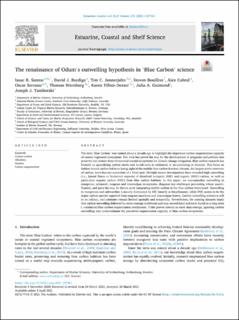| dc.description.abstract | The term ‘Blue Carbon’ was coined about a decade ago to highlight the important carbon sequestration capacity of coastal vegetated ecosystems. The term has paved the way for the development of programs and policies that preserve and restore these threatened coastal ecosystems for climate change mitigation. Blue carbon research has focused on quantifying carbon stocks and burial rates in sediments or accumulating as biomass. This focus on habitat-bound carbon led us to losing sight of the mobile blue carbon fraction. Oceans, the largest active reservoir of carbon, have become somewhat of a blind spot. Multiple recent investigations have revealed high outwelling (i.e., lateral fluxes or horizontal exports) of dissolved inorganic (DIC) and organic (DOC) carbon, as well as particulate organic carbon (POC) from blue carbon habitats. In this paper, we conceptualize outwelling in mangrove, saltmarsh, seagrass and macroalgae ecosystems, diagnose key challenges preventing robust quantification, and pave the way for future work integrating mobile carbon in the blue carbon framework. Outwelling in mangroves and saltmarshes is usually dominated by DIC (mostly as bicarbonate), while POC seems to be the major carbon species exported from seagrass meadows and macroalgae forests. Carbon outwelling science is still in its infancy, and estimates remain limited spatially and temporally. Nevertheless, the existing datasets imply that carbon outwelling followed by ocean storage is relevant and may exceed local sediment burial as a long-term (>centuries) blue carbon sequestration mechanism. If this proves correct as more data emerge, ignoring carbon outwelling may underestimate the perceived sequestration capacity of blue carbon ecosystems. | en_US |
